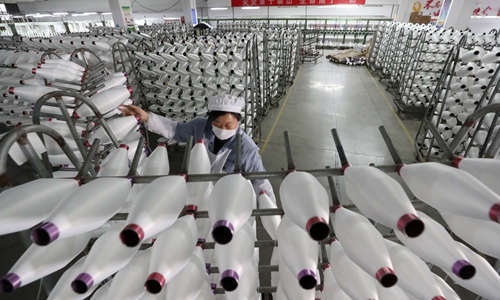Easing real economy liquidity crunch
Source:Xinhua Published: 2020/4/13 17:33:41
Policy support revitalizes micro, small and middle-sized firms

An employee at a local wire factory in Nantong, East China's Jiangsu Province monitors an automatic production line on March 4. Photo: IC
Lu Xiaoliang, general manager of Lanshan Motor Company Ltd based in Yuyao City in East China's Zhejiang Province, can now take a breather as his previously cash-strapped company has obtained over 1.8 million yuan ($256,000) through discounted bills.
The small-sized electrical machinery maker raised the money from CITIC Bank, a major commercial lender in China, at an interest rate of 2.75 percent, which largely reduced its financing costs. Having faced cash strains since resuming work in mid-February, it has finally solved its fund shortage in the purchase of raw materials, Lu said.
The company's success in raising funds at lower costs comes as China has adopted a mix of measures to prop up credit support for the real economy, especially for small and medium-sized firms.
According to a recent State Council executive meeting, the People's Bank of China (PBC) has implemented a 300 billion yuan special re-lending quota, which has so far supported more than 7,000 key enterprises involved in the response to the outbreak.
Another re-lending quota totaling 500 billion yuan is now supporting an increasing number of micro, small and medium-sized firms gain loans at rates below 4.55 percent, the meeting said.
The latest PBC data showed that new yuan-denominated loans hit 7.1 trillion yuan in the first quarter (Q1), up 1.29 trillion yuan from the same period last year.
In March alone, the figure amounted to 2.85 trillion yuan, a year-on-year rise of 1.16 trillion yuan.
Q1 loans were mainly channeled into the real economy, with 85.1 percent of the total going to enterprises and public institutions, Ruan Jianhong, a PBC official, told a Friday press briefing.
Since the beginning of 2020, the central bank has been offering reasonable and sufficient liquidity to the market through policy toolkits including across-the-board and targeted reserve requirement ratio cuts and open market operations, leading to a drop in market interest, said Dong Ximiao, a researcher with the National Institution for Finance and Development.
At the end of March, the outstanding amount of social financing, a measurement of funds that individuals and non-financial firms receive from the financial system, was at 262.24 trillion yuan, up 11.5 percent year-on-year.
Of the total, 60.6 percent, or 158.82 trillion yuan, went to the real economy, up 12.7 percent from the previous year.
Wen Bin, chief researcher with China Minsheng Bank, said the financial sector's capability of supporting the real economy had been continuously enhanced as the country's counter-cyclical adjustments in monetary policy were taking effect.
On the lending cost side, the general loan interest rate had declined by 0.26 percentage points since the beginning of the year, showing that the monetary policy effects had been transmitted to the real sector, said PBC official Sun Guofeng.
Positive signs were also evident in loans for the consumption sector, which is widely considered crucial in coping with the fallout of the coronavirus and bolstering broader economic activities.
In March, newly added consumption loans to individuals stood at 609.4 billion yuan, reversing a net losing streak in February.
However, there are still small and medium-sized firms facing cash crunches, Dong said, noting that measures should be taken to further stimulate banks' willingness to lend.
With gradual work resumption at major projects, the Q2 loan demand index is projected to grow 17.1 percentage points from Q1, according to a PBC survey.
China should step up credit support for major "new infrastructure" and livelihood projects, facilitate consumption upgrading and increase loans to private businesses and small firms, experts said.
RELATED ARTICLES:
Posted in: ECONOMY